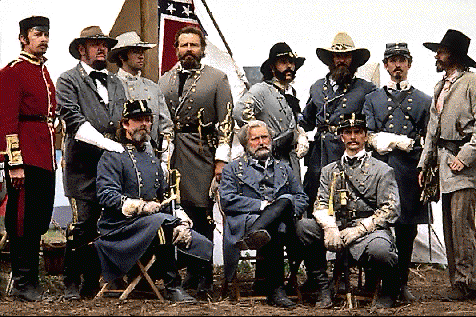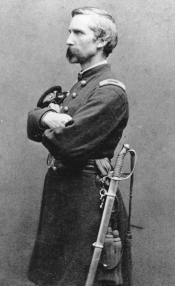Gettysburg
Produced 1993 by Turner Pictures, the 1st feature film by Ted's new film division, in 35mm widescreen 1.78:1 color, Dolby Digital 5:1 sound, 258 mins., also produced as a 6-hour television miniseries for TNT
Released as feature film Oct. 8, 1993, by New Line Cinema; as TV miniseries July 1994 by Turner Network Television, as laserdisc in March 1995 with added footage for a length of 271 mins., as widescreen VHS videotape in 1995 by Turner Home Entertainment at the theatrical length of 258 mins., released as DVD Dec. 1, 2000
Directed by Ronald F. Maxwell
Screenplay by Ronald F. Maxwell; based on the 1973 novel The Killer Angels by Michael Shaara.
Cinematography by Kees Van Oostrum

Cast
- Lieutenant General James Longstreet -- Tom Berenger
- General Robert E. Lee -- Martin Sheen
- Major General George E. Pickett -- Stephen Lang
- Brigadier General Lewis A. Armistead -- Richard Jordan
- Colonel Joshua Lawrence Chamberlain -- Jeff Daniels
- Brigadier General John Buford -- Sam Elliott
- Lieutenant Thomas D. Chamberlain -- C. Thomas Howell
- Sergeant Buster Kilrain -- Kevin Conway
- Brigadier General Richard B. Garnett -- Andrew Prine
- Colonel Strong Vincent -- Maxwell Caulfield
- Major General George G. Meade -- Richard Anderson
- Lieutenant Colonel Arthur Freemantle -- James Lancaster
- Brigadier General James L. Kemper -- Royce Applegate
- Major General Winfield Scott Hancock -- Brian Mallon
- Major General J. E. B. Stuart -- Joseph Fuqua
Notes
Robert Maxwell sold a 400-page script to Polygram in 1980 for a film with Robert Duval and William Hurt, but the company went bankrupt. Maxwell went to Kevin Costner in 1989, but the actor was busy with Dances With Wolves. Maxwell started a TV production in 1991 with ABC, but then interest shifted to the Gulf War. In March 1991, due to the success of Ken Burns TV series The Civil War, Turner committed TNT to produce the script for $13 million. Martin Sheen was the last-ditch choice for Robert E. Lee after the role was turned down by Duval, George C. Scott, and Albert Finney. Maxwell persuaded Turner to produce a feature film as well as a miniseries, and the 70mm film with Dolby sound increased the budget to $18 million. Promotional costs and a block party for the people of Gettysburg on Oct. 13 added more to the budget. Turner was given the rare permission by the National Park Service to film on the Gettysburg battlefield in exchange for a donation of $100,000 for battlefield preservation. The cast also included 5000 re-enactors who brought with them authentic uniforms and equipment.
 Joshua Lawrence Chamberlain, from PHS
Joshua Lawrence Chamberlain, from PHS
|
The film follows the modern interpretation of the Civil War as the shared heritage of North and South, stressing the bravery and heroism of soldiers on both sides. It also follows the modern critique of Robert E. Lee's leadership, favoring the viewpoint of James Longstreet that emerged from Shaara's novel. But a weakness of the film is its focus on a few major characters rather than the larger context of the battle, allowing only about 30% of the battle to be presented on film. Nothing is shown of the fight in the northern part of the battlefield for Culp's Hill. Instead, the focus on the second day is on Little Round Top in the southern battlefield. Joshua Chamberlain was the 34-year old professor of rhetoric from Bowdoin College and commander of the 20th Maine. The film portrays his speech to 120 mutineers that convinces all but 6 to continue fighting because "we are here for something new. . . to set other men free. America should be free ground, all of it . . . from here to the Pacific Ocean. . . Here you can be somebody. Here is the place to build a home. It's not the land. It's the idea that we all have value, you and me. What we're fighting for, in the end, we're fighting for each other." Actually, the mutineers from the 2nd Maine Regiment were assigned to the 20th Regiment in May and Chamberlain had spent much time with them before Gettysburg. They were not offered amnesty at Little Round Top but afterward, as a result of Chamberlain's battle report. The film does not show the larger context of the battle at Little Round Top. It does not show the CSA attackers, the 15th Alabama led by Col. William Oates who lost a brother in the the battle of Gettysburg. Oates had earlier taken Big Round Top unopposed, planned to use it for artillery, but Gen. Evander Law of the Alabama Brigade ordered Oates to take Little Round Top. The Union troops of Col. Vincent's Brigade defending Little Round Top included 4 regiments from Maine, Pennsylvania, New York, Michigan, with the 20th Maine arriving only 10 minutes before the CSA attack. Vincent's Brigade stopped the repeated attacks of Oates' Brigade, and finally Lt. Holman Melcher charged alone when Chamberlain's voice could not be heard, helped by Union sharpshooters and artillery on both flanks. The 20th Maine did act bravely and lost 130 of 386 in its defense of Little Round Top.
The film implies that a Confederate victory north of Gettysburg on the first day caused Lee to decide to attack the Union army. But Doubleday and Howard stopped the Confederate attack. Hancock made a decision to withdraw to Cemetery Hill for the purpose of creating a strong defensive position south of Gettysburg, not because he had been defeated north of the town. The film shows nothing of Lee's echelon plan starting on the second day to attack in waves from south to north. It shows nothing of the tremendous battles in Devil's Den, the Peach Orchard, the Wheat Field, along Plum Run. There is nothing about Dan Sickles' defense of the Union line in the south with only his one corps, of Hancock ordering Col. William Colville's small 1st Minnesota regiment to attack the full brigade of Cadmus Wilcox in the Wheat Field, charging with fixed bayonets, leaving only 47 of 262 surviving, an 82% casualty rate, highest of any Union regiment in the war. There is nothing of the tragic death of William Dorsey Pender, hit in the leg while riding his horse, dying after amputation, unable to order his division into battle, causing Lee's echelon plan to collapse. Lee said if Pender had stayed in the saddle another half hour, he would have won the battle on the second day. There is nothing about Jubal Ealy's late afternoon attack in the north on Cemetery Hill, almost succeeding when Alexander Hays and his Louisiana Tigers seized the federal guns around Evergreen Cemetery, but were defeated when Hancock ordered in the brigade of Samuel "Bricktop" Carroll. There is nothing about the early morning attack by the Stonewall Brigade at Culp's Hill, stopped by artillery enfilade from Union guns on the top of the hills, the critical high ground that Gen. John Buford had emphasized at the beginning of the battle was the key to victory. There is nothing of David Gregg's victory over Jeb Stuart at Cress's Ridge three miles east of Gettysburg at noon on the third day, preventing Stuart from attacking the Union lines to divert defenses away from stopping Pickett's Charge. There is nothing about George Stannard and his Vermont brigade that began from the south to envelop the confederate attackers as Pickett's men began their left oblique movement, bringing crossfire from 2 directions down on the confederates.
RESOURCES:
- Rainer, Peter "Epic 'Gettysburg' Provides Evenhanded History Lesson," film review in Los Angeles Times, October 8, 1993,p. F6
- Galbraith, Jane, "Half a Score and Three Years Ago..." film review in Los Angeles Times, Oct. 5, 1993, p. F1
- Wloszczyna, Susan, "'Gettysburg': Ted Turner's Painfully Long Labor of Love," Life, Oct. 8, 1993.
- review, New York Times, October 8, 1993, The Living Arts, p. B2
- review, Journal of American History, December 1994, p. 1398
- Latham, G.A. "Fact or Fiction: Colonel Joshua L. Chamberlain at Gettysburg as Depicted in Michael Shaara's The Killer Angels," M.A. Thesis, Army Command and Staff College, NTIS #ADA 241-773
Links:
revised 12/10/00 by Schoenherr | Filmnotes | Civil War topics
